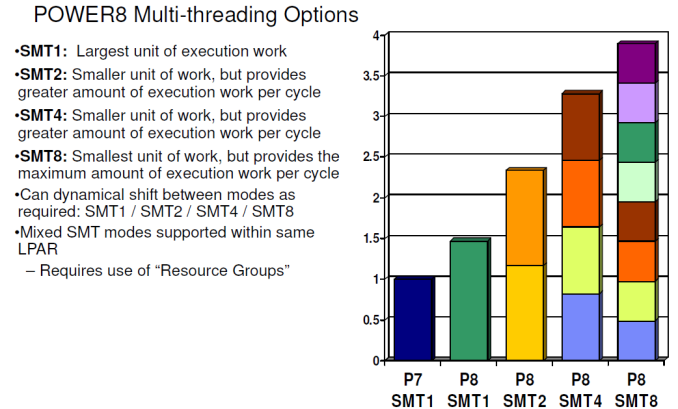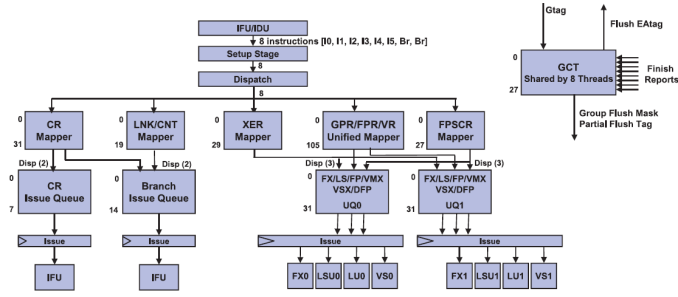Assessing IBM's POWER8, Part 1: A Low Level Look at Little Endian
by Johan De Gelas on July 21, 2016 8:45 AM ESTMulti Threading Prowess
The gains of 2-way SMT (Hyperthreading) on Intel processors are still relatively small (10-20%) in many applications. The reason is that threads have to share most of the critical resources such as L1-cache, the instruction TLB, µop cache, and instruction queue. That IBM uses 8-way SMT and still claims to get significant performance gains piqued our interest. Is this just benchmarketing at best or did they actually find a way to make 8-way SMT work?
It is interesting to note that with 2-way SMT, a single thread is still running at about 80% of its performance without SMT. IBM claims no less than a 60% performance increase due to 2-way SMT, far beyond what Intel has ever claimed (30%). This can not be simply explained by the higher amount of issue slots or decoding capabilities.
The real reason is a series of trade-offs and extra resource investments that IBM made. For example, the fetch buffer contains 64 instructions in ST mode, but twice as many entries are available in 2-way SMT mode, ensuring each thread still has a 64 instruction buffer. In SMT4 mode, the size of the fetch buffer for each thread is divided in 2 (32 instructions), and only in SMT8 mode things get a bit cramped as the buffer is divided by 4.
The design philosophy of making sure that 2 threads do not hinder each other can be found further down the pipeline. The Unified Issue Queue (UniQueue) consists of two symmetric halves (UQ0 and UQ1), each with 32 entries for instructions to be issued.
Each of these UQs can issue instructions to their own reserved Load/Store, Integer (FX), Load, and Vector units. A single thread can use both queues, but this setup is less flexible (and thus less performant) than a single issue queue. However, once you run 2 threads on top of a core (SMT-2), the back-end acts like it consists of two full-blown 5-way superscalar cores, each with their own set of physical registers. This means that one thread cannot strangle the other by using or blocking some of the resources. That is the reason why IBM can claim that two threads will perform so much better than one.
It is somewhat similar to the "shared front-end, dual-core back-end" that we have seen in Bulldozer, but with (much) more finesse. For example, the data cache is not divided. The large and fast 64 KB D-cache is available for all threads and has 4 read ports. So two threads will be able to perform two loads at the same time. Another example is that a single thread is not limited to one half, but can actually use both, something that was not possible with Bulldozer.
Dividing those ample resources in two again (SMT-4) should not pose a problem. All resources are there to run most server applications fast and one of the two threads will regularly pause when a cache miss or other stalls occur. The SMT-8 mode can sometimes be a step too far for some applications, as 4 threads are now dividing up the resources of each issue queue. There are more signs that SMT-8 is rather cramped: instruction prefetching is disabled in SMT-8 modus for bandwidth reasons. So we suspect that SMT-8 is only good for very low IPC, "throughput is everything" server applications. In most applications, SMT-8 might increase the latency of individual threads, while offering only a small increase in throughput performance. But the flexibility is enormous: the POWER8 can work with two heavy threads but can also transform itself into a lightweight thread machine gun.












124 Comments
View All Comments
HellStew - Wednesday, July 27, 2016 - link
It depends what kind of software you are running. If you are running giant backend workloads on x86, you can seamlessly migrate that data to PPC while keeping custom front ends running on x86.aryonoco - Saturday, July 23, 2016 - link
Johan, maybe the little endian-ness makes a difference in porting proprietary software, but pretty much all open source software on Linux has supported BE POWER for a long time.If you get the time and the inclination Johan, it would be great if you could say do some benchmarks on BE RHEL 7 vs LE RHEL 7 on the same POWER 8 system. I think it would make for fascinating reading in itself, and would show if there are any differences when POWER operates in BE mode vs LE mode.
aryonoco - Saturday, July 23, 2016 - link
Actually scrap that, seems like IBM is fully focusing on LE for Linux on POWER in future. I'm not sure there will be many BE Linux distributions officially supporting POWER9 anyway. So your choice of focusing on LE Linux on POWER is fully justified.HellStew - Wednesday, July 27, 2016 - link
Side note: Once you are running KVM, you can run any mix of BE and LE linux varieties side by side. I'm running FedoraBE, SuSE BE, Ubuntu LE, CentOS LE, and (yes a very slow copy of windows) on one of these chipsrootbeerrail - Saturday, July 23, 2016 - link
If a machine is completely isolated, it doesn't matter much to the machine. I personally find BE easier to read in hex dumps because it follows the left-to-right nature of English numbers, but there are reasons to use LE for human understanding as well.The problem shows up the instance one tries to interchange binary data. If the endian order does not match, the data is going to get scrambled. Careful programming can work around this issue, but not everyone is a careful programmer - there's a lot of 'get something out the door' from inexperienced or lazy people. If everything is using the same conventions (not only endian, but size of the binary data types (less of a problem now that most everything has converged to 64-bit)), it's not an issue. Thus having LE on Power makes the interchange of binary data easier with the X86 world.
errorr - Friday, July 22, 2016 - link
Great Article! Just an FYI, the term "just" as in "just out" on the first page has different meanings on opposite sides of the Atlantic and is usually avoided in writing for international audiences. I'm not quite sure which one is used her. The NaE would mean 'just out' in that it had come out right before while the BrE would mean it came out right after the time period referenced in the sentence.xCalvinx - Friday, July 22, 2016 - link
awesome!!..keepup the good work..looking forward to Part2!! ... actualy cant wait.. hurryup lol.. :)double thumbsup
Mpat - Friday, July 22, 2016 - link
Skylake does not have 5 decoders, it is still 4. I know that that segment of the optimization manual is written in a cryptic way, but this's what actually happened: up until Broadwell there are 4 decoders and a max bandwidth from the decoder segment of 4 uops. If the first decoder (the complex one) produces 4 uops from one x86 op, the other decoders can't work. If the first produces 3, then the second can produce 1, etc. this means that the decoders can produce one of these combinations of uops from an x86 op, depending on how complex a task the first decoder has: 1/1/1/1, 2/1/1, 3/1, or 4. Skylake changes this so the max bandwidth from that segment is now 5, and the legal combinations become 1/1/1/1, 2/1/1/1, 3/1/1, and 4/1. You still can't do 1/1/1/1/1, so there is still only 4 decoders. Make sense?ReaperUnreal - Friday, July 22, 2016 - link
Why do the tests with GCC? Why not give each platform their full advantage and go with ICC on Intel and xLC on Power? The compiler can make a HUGE difference with benchmarks.Michael Bay - Saturday, July 23, 2016 - link
It`s right in the text why.